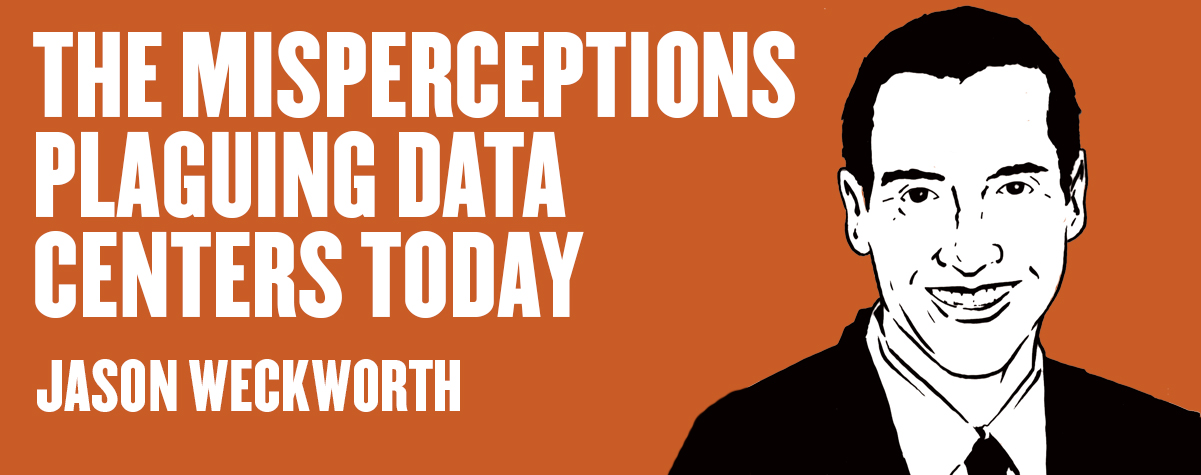RagingWire’s Jason Weckworth Discusses the Execution of IT Strategy
In this series, Uptime Institute asked three of the industry’s most well recognized and innovative leaders to describe the problems facing enterprise IT organizations. Jason Weckworth examined the often-overlooked issue of server hugging; Mark Thiele suggested that service offerings often did not fit the customer’s long-term needs; and Fred Dickerman found customers and providers at fault.
Q: What are the most prevalent misconceptions hindering data center owners/operators trying to execute the organization’s IT strategy, and how do they resolve these problems?
Jason Weckworth: As a colocation provider, we sell infrastructure services to end users located throughout the country. The majority of our customers reside within a 200-mile radius. Most IT end users say that they need to be close to their servers. Yet remote customers, once deployed, tend to experience the same level of autonomy and feedback from their operations staffs as those who are close by. Why does this misconception exist?
We believe that the answer lies in legacy data center services vs. the technology of today’s data centers with the emergence of DCIM platforms.
The Misconception: “We need to be near our data center.”
The Reality: “We need real-time knowledge of our environment with details, accessibility, and transparent communication.”
As a pure colocation provider (IaaS), we are not in the business of managed services, hosting, or server applications. Our customers’ core business is IT services, and our core business is infrastructure. Yet they are so interconnected. We understand that our business is the backbone for our customers. They must have complete reliance and confidence in everything we touch. Any problem we have with infrastructure has the potential to take them off-line. This risk can have a crippling effect on an organization.
The answer to remote access is remote transparency.
Data Center Infrastructure Management (DCIM) solutions have been the darlings of the industry for two years running. The key offering, from our perspective, is real-time monitoring with detailed customization. When customers can see their individual racks, circuits, power utilization, temperature, and humidity, all with real-time alarming and visibility, they can pinpoint their risk at any given moment in time. In our industry, seconds and minutes count. Solutions always start with first knowing if there is a problem, and then, by knowing exactly the location and scope of that problem. Historically, customers wanted to be close to their servers so that they could quickly diagnose their physical environment without having to wait for someone to answer the phone or perform the diagnosis for them. Today, DCIM offers the best accessibility.
Remote Hands and Eyes (RHE) is a physical, hands-on service related to IT infrastructure server assets. Whether the need is a server reboot, asset verification, cable connectivity, or tape change, physical labor is always necessary in a data center environment. Labor costs are an important consideration of IT management. While many companies offer an outsourced billing rate that discourages the use of RHE as much as possible, we took an insurance policy approach by offering unlimited RHE for a flat monthly fee based on capacity. With 650,000 square feet (ft2) of data center space, we benefit greatly from scaling the environment. While some customers need a lot of services one month, others need hardly any at all. But when they need it, it’s always available. The overall savings of shared resources across all customers ends up benefitting everyone.
Customers want to be close to their servers because they want to know what’s really going on. And they want to know now. “Don’t sugarcoat issues, don’t spin the information so that the risk appears to be less than reality, and don’t delay information pending a report review and approval from management. If you can’t tell me everything that is happening in real time, you’re hiding something. And if you’re hiding something, then my servers are at risk. My whole company is at risk.” As the data center infrastructure industry has matured over the past 10 years, we have found that customers have become much more technical and sophisticated when it comes to electrical and mechanical infrastructure. Our solution to this issue of proximity has been to open our communication lines with immediate and global transparency. Technology today allows information to flow within minutes of an incident. But only culture dictates transparency and excellence in communication.
As a senior executive of massive infrastructure separated across the country on both coasts, I try to place myself in the minds of our customer. Their concerns are not unlike our own. IT professionals live and breathe uptime, risk management, and IT capacity/resource management. Historically, this meant the need to be close to the center of the infrastructure. But today, it means the need to be accessible to the information contained at the center. Server hugging may soon become legacy for all IT organizations.
Jason Weckworth is senior vice president and COO, RagingWire Data Centers. He has executive responsibility for critical facilities design and development, critical facilities operations, construction, quality assurance, client services, infrastructure service delivery, and physical security. Mr. Weckworth brings 25 years of data center operations and construction expertise to the data center industry. Previous to joining RagingWire, he was owner and CEO of Weckworth Construction Company, which focused on the design and construction of highly reliable data center infrastructure by self-performing all electrical work for operational best practices. Mr. Weckworth holds a bachelor’s degree in Business Administration from the California State University, Sacramento.


